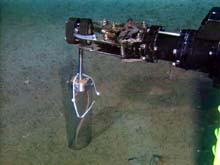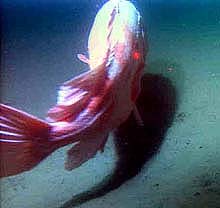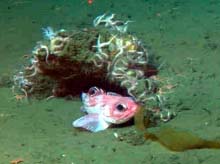
A thornyhead rockfish hides under a rock covered with brittle stars and faces a piece of kelp draped along the soft, muddy bottom. This is the fish's preferred habitat. Click image for larger view.
A thornyhead rockfish hides under a rock covered with brittle stars and faces a piece of kelp draped along the soft, muddy bottom. This is the fish's preferred habitat. Click image for larger view.
All About Rockfish
July 1, 2001
Jeff Goodrich, Teacher-at-sea
Earth Science Teacher
Lake Oswego High School
Lake Oswego, Oregon.
and
Susan Merle, Geological Research Assistant
CIMRS Program, Oregon State University
Vents Program, Pacific Marine Environmental Laboratory, NOAA
Dive R599 of the ROPOS remotely operated vehicle (ROV) was the first dive on the northern wall of Astoria Canyon. The dive began 4:30 pm (PST) on June 30 and ended at 11 am the following morning. ROPOS descended to a depth of 600 m, then ascended to the top of the wall at 150 m. This dive contained the greatest diversity of rockfish we have seen so far, including the thorneyhead, redbanded, greenstriped, sharpchin, rosethorn, canary and our first yelloweye. We also saw a great number of flatfish, such as Dover sole, rex sole and halibut. Other fish included eelpouts, sablefish, poachers and sculpins. A cat shark darted across our path during the transect.
The nighttime dive activities focused on geology and invertebrate exploration in water depths of 150-300 m. The geologists' primary focus was to investigate a major landslide area composed of many small slides. Just below the rim of the canyon wall, we took our first push-core sample in horizontal bedding planes composed of claystone and unconsolidated sediments. Invertebrates spotted during the nighttime operations included sponges, sea stars, crinoids, and numerous psolids (armored sea cucumbers).
We returned to doing fish transects with the light of day, starting at a depth of 450 m, midway up the northern wall in soft, muddy sediments. The diversity and abundance of fish was not as great as during the earlier fish transects. Upon reaching the top of the wall, however, we landed in rockier habitat and saw our first yellowtail and widow rockfish of the cruise, as well as another canary rockfish. Samples from the dive included two sediment core samples and a friable rock, sea stars, sponges, and water samples.
Read the following statement from cameraman Peck Euwer, and the interview with groundfish biologist Mary Yoklavich, for more perspectives on the expedition to Astoria Canyon.
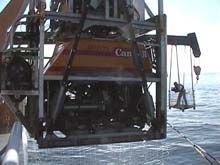
Peck Euwer, the cameraman in the basket extended from the ship's crane (far right), films the ROPOS recovery from a unique angle. Click image for larger view.
Gordon Hendler, Curator of Echinoderms at the Natural History Musum of Los Angeles County, CA, retrieves a large sea star gathered by ROPOS. Sound mixer Mike Kasic, part of the film crew, is in the background. Click image for larger view.
Documenting the Expedition
Peck Euwer, Cameraman
July 1, 2001
I am a member of a two-man film crew on the Ocean Exploration cruise to Astoria Canyon. Our goal is to document the cruise in every way possible, so that there is both a documentary record of the cruise and a potential film for television. So far, we have been able to film almost all of the wide variety of scientific elements that are part of this unbelievably dynamic expedition.
In our efforts to get into each element of the cruise, from interviewing the captain to filming the launch and recovery of the ROPOS, we have learned about what the "deep scattering layer" is, and how sidescan sonar works. In the end, I hope that these images and interviews can be passed on to a wide audience around the world, and that millions of people can become a part of this unique expedition.
An Interview with Mary Yoklavich
Groundfish Biologist, National Marine Fisheries Service, NOAA
July 1, 2001
Ocean Explorer Team: What type of research are you conducting at Astoria Canyon?
Mary Yoklavich: I specialize in groundfish. Over the past 25 yrs, my research has largely centered on rockfish, their age and growth. I've also done all kinds of work on their reproduction. It's a cool group of fish. Their internal fertilization and release of millions of live young all at once is really unusual. When the young are released, they have a functional mouth, gut and eyes, which is also unusual. Unfortunately, there's no easy way to collect these fish. So we're developing entirely new keys to identify them underwater. This is important because they look totally different underwater, in their own habitat, than they do when you get them from a trawl or see them on deck. We are currently writing a book, Rockfishes of the Northeast Pacific, on everything you ever wanted to know about rockfish, including their identification.
Ocean Explorer Team: Is it true that rockfish can live for extremely long periods of time.
Mary Yoklavich: Yes. Some of them live for up to 150 yrs. It's only in the last 20 yrs that we've realized that these fish can live that long.
Ocean Explorer Team: If they live that long, what type of reproductive rates do they have?
Mary Yoklavich: Their production rate is low, because they live a long time and are very slow growing. They do produce a lot of young, but very few survive, so recruitment -- the number or weight of catchable fish added to a stock each year by growth and migration -- is extremely variable from year to year. It depends largely on ocean conditions. Some of these fish may go for two decades and not have a high recruitment rate. That's part of the problem with their declining numbers. We've been managing them based on other fisheries with higher productivity rates. Now, we're drastically cutting back on allowable catches on most rockfish.
Ocean Explorer Team: What's the most exciting thing about studying rockfish on this Ocean Exploration cruise to Astoria Canyon?
Mary Yoklavich: I think it's exciting to get the perspective of being in their habitat, being in their environment. I don't think fishermen or scientists can fully comprehend what we're dealing with until we go down there and check out the habitat. It's fascinating. It gives you a different perspective. A lot of scientists who study oceans for most of their lives don't get to use tools such as the ROPOS ROV to check out what's going on at the bottom. I'm also excited about taking back to California some of the things we're finding at Astoria Canyon, so I can compare them with some of the canyon projects I'm working on there. It's giving me the chance to better understand rockfish habitats elsewhere.
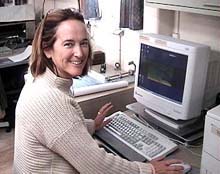
Mary Yoklavich is a research fishery biologist at NOAA's Southwest Fisheries Science Center in the Santa Cruz Laboratory of the National Marine Fisheries Service.
Sign up for the Ocean Explorer E-mail Update List.






























